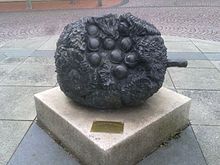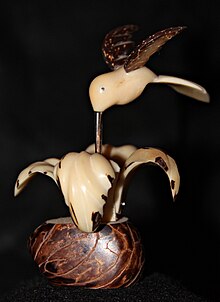Corozo
The ivory nut , also tagua nut or Corozonuss called, is the seed or the endosperm of palm trees , the genus of the ancient phytelephas ( Phytelephas belong). They come from Phytelephas macrocarpa (Syn .: Phytelephas schottii ) or Phytelephas aequatorialis .
distribution
The 5 to 15 meter high cornet palms grow mainly in Ecuador , but also in Panama , Colombia , Brazil and Peru . They prefer moist locations and can be found up to an altitude of 1800 meters.
leaves
The up to 6 meters long and 1 meter wide, pinnate leaves are ideal for covering huts. Cords and brooms can be made from the fibers of the leaves.
nuts

The inflorescence of the rarer male plant is a simple, fleshy cob with densely packed flowers which, when fully developed, can spread a deafening smell through the forest. The female plants annually produce around 20 head-sized, crusty, woody and thorny fruit balls that hang directly on the palm trunk and are only harvested with an ax or machete because of their hardness . They are divided into chambers and contain, embedded in the pulp, several dozen seeds ( nuts ) up to the size of a chicken egg.
After the harvest, the "nuts" are still soft and contain a tartaric, drinkable liquid. The nuts selected for processing are dried in the sun for several months. In doing so, they gradually become firmer until they finally - and this is what is special about the corozo - attain the hardness of bones through and through. An ivory-colored material (endosperm) now appears beneath a brown-black outer skin, which can be sawed, milled, turned, carved, polished and also colored. It does not peel and is surprisingly insensitive to impact and abrasion. If it is exposed to sunlight for a long time, it darkens. By heating in the fire, the surface can be given a light brown color in which a marbled structure becomes visible.
The indigenous population in the areas where the Tagua palm is distributed had known the useful stone nuts for many generations and made all sorts of items such as jewelry, combs, toothpicks and saws from them. Through the maritime trade, stone nuts became known in Europe, but also in Far Eastern countries. Different types and qualities were distinguished and named after their ports of shipment (e.g. "Cartagena", "Gujaquil", "Little Savanilla").
Because of their low price tagua nuts were used as a cheap substitute for the much more expensive ivory . So knobs, chess pieces, dice, pipe bowls, buttons, figures, toys and much more were made from them. Japanese miniature carvings ( netsuke ) made from this material are also known .
The company Jacob Frank in Linden produced the late 19th century, with around 150 employees, buttons made of ivory nut. Commercial use peaked in the 1920s when tons of it were made into buttons. After the Second World War , production declined as the tagua nut was replaced by plastics in the manufacture of buttons . This only changed again in the 1970s in the wake of the ecological movement , when international organizations rediscovered the tagua nut as an ivory substitute to save the elephants threatened with extinction by the ivory trade . The indigenous population was encouraged to plant tagua palms and encouraged them to process them artistically.
Ground stone nuts are also used in cosmetics as a peeling material.
See also
- Doum palms
- Metroxylon amicorum , Metroxylon warburgii
Web links
- Corozo in the jewelry dictionary of Prof. Leopold Rössler.
- Schmöllner buttons: World fame with the corozo button on burg-posterstein.de.
- Vegetable Ivory at Palomar College.
- The Tagua or stone nut in Fascination Rainforest.
Individual evidence
- ↑ Theodor Unger : Guide through the city and its buildings. Festschrift for the fifth general assembly of the Association of German Architects and Engineers' Associations. 1882, reprint: Th. Schäfer, 1996, p. 246, limited preview in the Google book search.


